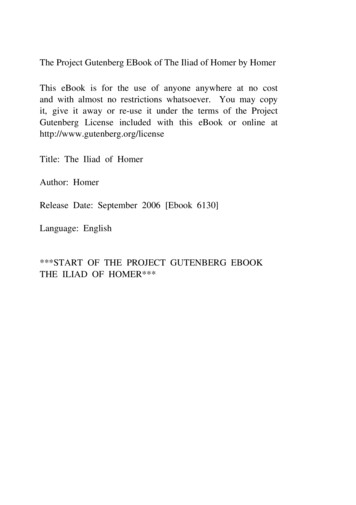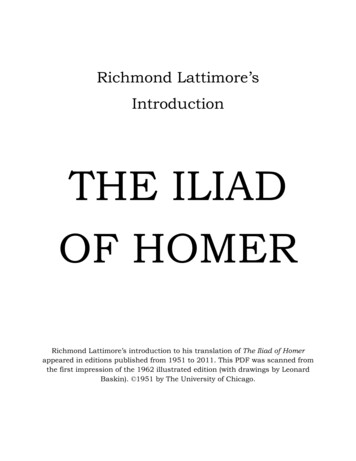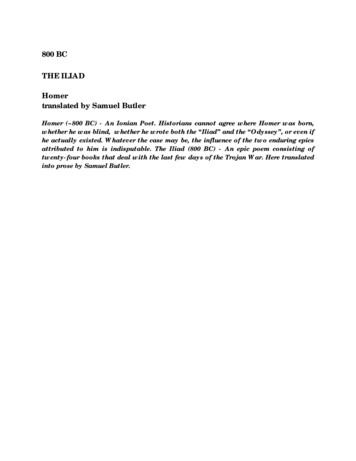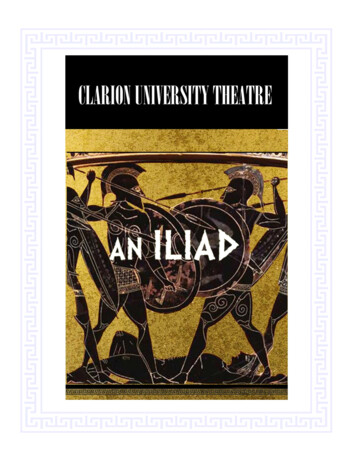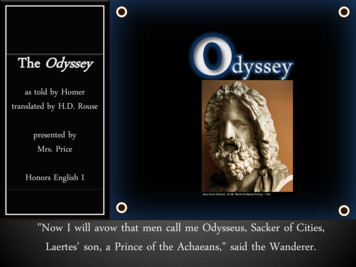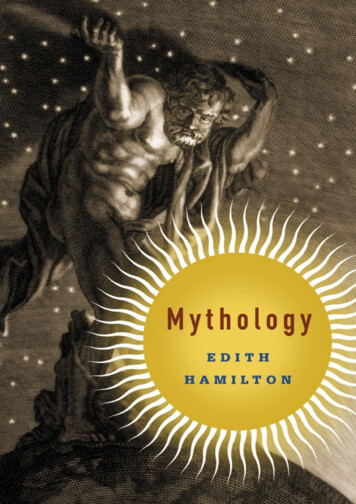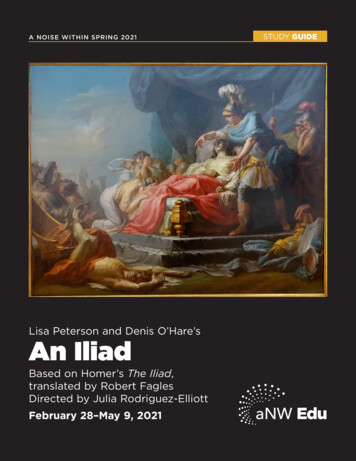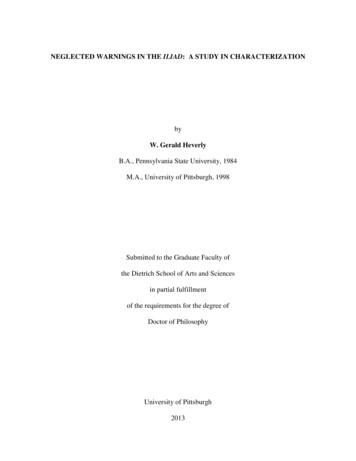
Transcription
NEGLECTED WARNINGS IN THE ILIAD: A STUDY IN CHARACTERIZATIONbyW. Gerald HeverlyB.A., Pennsylvania State University, 1984M.A., University of Pittsburgh, 1998Submitted to the Graduate Faculty ofthe Dietrich School of Arts and Sciencesin partial fulfillmentof the requirements for the degree ofDoctor of PhilosophyUniversity of Pittsburgh20131
UNIVERSITY OF PITTSBURGHARTS AND SCIENCESThis dissertation was presentedbyW. Gerald HeverlyIt was defended onMarch 6, 2013and approved byDennis Looney, PhD, Professor, Department of French and ItalianAndrew Miller, PhD, Professor Emeritus, Department of ClassicsMae Smethurst, PhD, Professor, Department of ClassicsDissertation Advisor: Edwin Floyd, PhD, Professor, Department of Classicsii
Copyright by W. Gerald Heverly2013iii
NEGLECTED WARNINGS IN THE ILIAD: A STUDY IN CHARACTERIZATIONW. Gerald Heverly, PhDUniversity of Pittsburgh, 2013A neglected warning is a narrative sequence consisting of three moves: a credible warning isissued, the recipient disregards it, and he suffers some calamity as a result. Neglected warningsare common in folklore and literature.They have been studied closely in Herodotus,Thucydides, and Sophocles, but not in Homer. The little that has been said about neglectedwarnings in his poetry focuses on the recurring traits of warners and recipients and lacksconsensus. Attempting to remedy the situation, this dissertation systematically investigates howthe Iliad’s twelve neglected warnings help characterize members of both groups.Warners and recipients turn out to be distinct character types. All the examples feature awarner who is male, wise, old, actively benevolent, and sympathetic. Furthermore, warners arevery often paternal or prophetic. Sometimes one or more attributes are insinuated by the poetrather than being literally true. Recipients, by contrast, are always young men who are selfishlyambitious, bold, and reckless.Thus, a strong contrast in characterization obtains acrossexamples. In addition, Homer consistently pairs one warner with one recipient, and recipientsfrequently recover in some way from the disasters that they provoke.These conclusions augment or correct existing observations about the neglected warningpattern in Homer. The results also support a previously unsubstantiated claim that it derivesfrom folklore. Specifically, the Iliad’s warners correspond to a stock character in folktalesknown as the Wise Old Man. For their part, neglectful recipients closely resemble the type ofiv
the disobedient hero, which occurs especially in cautionary tales. Some widely attested folktaleplots are built around interaction between a Wise Old Man figure and a disobedient hero whoexperiences misfortune by disregarding the elder’s advice. The overall scenario may well havebeen incorporated into the Greek poetic tradition, serving as a basis for the standard features ofneglected warnings in the Iliad. Directions for further research are suggested.v
TABLE OF CONTENTSPREFACE .VIII.INTRODUCTION .1II.WARNINGS NEGLECTED BY AGAMEMNON .15III.WARNINGS NEGLECTED BY ACHILLES .40IV.WARNINGS NEGLECTED BY PATROCLUS .63V.WARNINGS NEGLECTED BY HECTOR . .84VI.SUMMARY AND CONCLUSIONS . .105BIBLIOGRAPHY .121vi
PREFACEIt is a pleasure to acknowledge the many people who helped make this dissertation possible.First, I wish to thank my supervisor, Professor Edwin Floyd, for his invaluable advice, kindness,and dedication to working with me remotely.I am grateful to the other members of mycommittee as well, Professors Dennis Looney, Andrew Miller, and Mae Smethurst.Theirhelpful suggestions and encouragement have meant much.Others at the University of Pittsburgh have also been generous with their time. Theyinclude Elizabeth Conforti, the Classics Department’s administrator; Professor D. MarkPossanza, chairman of the department during the final years of my studies; and Professors JohnLyon and Bruce Venarde, each of whom discussed aspects of the project with me.In addition, I am indebted to a number of family members, friends, and colleagues. Fortheir support I thank Walter, Myrtle, George, and Heather Heverly; my friends Fayçal Bouguir,Mary Catherine Johnsen, and Damien Scheuerman; and my colleagues Evelyn Ehrlich, DawnLawson, Andrew Lee, and Michael Stoller. Besides encouraging me, Susan Dudash, DianaGreene, Jeanne Krochalis, and John Tofanelli all served as valuable sounding boards from timeto time.Most of the dissertation was researched and written during a year-long sabbatical. I amgrateful to my employer, New York University, Division of Libraries, for that opportunity.vii
I.INTRODUCTIONA neglected warning is a narrative sequence consisting of three moves: a warning is issued, therecipient disregards it, and he suffers some sort of calamity as a result. Neglected warningsoccur frequently in literature and folklore.1 A well-known example is the story of Orpheus andEurydice. As Vergil relates it, Orpheus is instructed not to look back at Eurydice while theymake their way from the underworld. Overcome by passion, he forgets the warning, looks, andloses her forever.2The Iliad has a dozen disregarded warnings. The aim of this dissertation is to study howthey contribute to characterization. What traits of advisors do neglected warnings illuminate?What traits of recipients? Are the characteristics of each group similar across examples, or dothey vary? These and related matters will be addressed. Before the investigation can begin,though, it is necessary to review scholarship about warnings in Homer, account for the selectionof examples to be examined, and briefly discuss the values of Homeric society in relation togiving and receiving advice. An overview of the dissertation’s remaining chapters will completethis introduction.1On neglected warnings in folklore, see Propp, Morphology of the Folktale, 26-28; Lüthi, EuropeanFolktale, 75-76; and Tatar, Off With Their Heads!, 22-42. On such episodes in drama, see Polti, ThirtySix Dramatic Situations, 61-64. Although these writers use their own terms for the neglected warningsequence, all describe a narrative structure that amounts to the same thing. Given the overall familiarityof folklorists and literary scholars with disregarded warnings, it is surprising that nobody from eithergroup has produced a general study of the topic.2Georgics 4.485-98.1
Given the general frequency of neglected warnings, it is not surprising that they are wellrepresented in Greek literature. Such warnings have, in fact, been the focus of investigation inseveral authors. Herodotus has attracted the most attention.3 The pattern has also been studiedin Thucydides and Sophocles.4 When it comes to Homer, however, scholars have little to sayabout disregarded warnings, and they agree on even less. The most that the literature affords isbrief remarks on selected warnings, in studies devoted to other matters. Nevertheless, the littlethat has been said is helpful background for the present study and will be now be summarized.Probably the first to comment explicitly on the neglected warning pattern in Homer isBischoff. Although he is primarily concerned with the pattern’s manifestations in Herodotus, hedevotes several pages to its Homeric antecedents. Bischoff recognizes that neglected warningshave their characteristic threefold structure in Homer. In addition, he generalizes that Homericwarners are wise elders, who are no longer able to fight, while those whom they caution areyoung, impulsive men.5 Unfortunately this account exaggerates. In the Iliad alone there arethree counterexamples. Achilles, who is younger than Patroclus, warns his friend not to fight allthe way to Troy. Patroclus does not heed the warning and is killed by Hector. Similarly,Poulydamas, who is the same age as Hector, warns the Trojan chief on two different occasions toretreat. Hector ignores the warning each time, and each time a massacre of the Trojans ensues.It is not always the case, then, that disregarded warners in Homer are literally older than thosewhom they caution, let alone elderly.3Highlights include Bischoff, Der Warner bei Herodot; Lattimore, “Wise Adviser in Herodotus”; andmore recently Shapiro, Role of Advice in Herodotus’ “Histories.”4On neglected warnings in Thucydides, see Hunter, Thucydides the Artful Reporter, 123-48; Marinatos,“Nicias as a Wise Advisor”; and Pelling, “Thucydides' Archidamus and Herodotus' Artabanus.”Lardinois, “Traces of the Adviser Figure” discusses neglected warnings in Sophocles.5See Bischoff, Der Warner bei Herodot, 1-5.2
Fenik is also aware of neglected warnings. In a chapter on divine anger in the Odyssey,he notes that Aegisthus, Odysseus’s crew, and the suitors all receive credible warnings that theyneglect to their great detriment. For Fenik, the examples illustrate the “motif of wise advicedisregarded.”6 What this expression designates, of course, is the neglected warning pattern. Inaddition to identifying its threefold structure, Fenik observes that warners in the Odyssey arealways wise and that neglectful recipients exhibit reckless folly to one degree or another.7In a short article on folly and delusion in Homer, Hooker discusses some of the sameexamples from the Odyssey as Fenik does. Like Fenik, he identifies the neglected warningpattern in his own terms, “advice given—advice not comprehended or not heeded—disaster tothe person advised.”8 Hooker believes that this narrative sequence accounts for much of thereckless behavior in the Odyssey. He also believes that it is borrowed from folklore. The latterclaim is not substantiated, but it has considerable merit.This will become clear in theconcluding chapter. For now what matters is that Hooker accurately identifies the neglectingwarning pattern’s structure, notes that warners are always wise, and allows misunderstanding andheedlessness as motives for recipients.West, too, observes neglected warnings in Homer. In his new commentary on the Iliad,he remarks, “It is a typical storyteller’s motif that someone who is to suffer disaster rejects thewarnings of a seer or wise counselor and imputes base motives to him.”9 West makes thisobservation in relation to one of the warnings from Poulydamas that Hector rejects. Westcharacterizes Achilles’ warning to Patroclus, which is also disregarded with disastrous results, as6Studies in the Odyssey, 210, 217.Studies in the Odyssey, 209-19.8“Odyssey and Iliad,” 6.9Making of the Iliad, ad 12.211-15.73
another instance of the same motif.10 Whether one calls it a motif, a device, or something else, itis clear that West finds occurrences of the neglected warning pattern in Homer.Besidesidentifying the pattern’s tripartite structure, West holds that warners are typically wise orprophetic. For their part, neglectful recipients are willful and attribute bad intentions to advisors.Others who discuss warnings in Homer say much that is of interest in its own right butnothing that is useful for the present investigation. Dürbeck, for example, compares a warning inthe Aethiopis with a similar one in the Iliad. In each case, Thetis tells Achilles not to fightanother warrior. Each time Achilles disobeys, making his death imminent. Dürbeck shows howa contradiction results from Thetis’s warning in the Aethiopis and how Homer avoids the sameinconsistency.11 The neglected warning pattern that Achilles illustrates is neither noted norexplored.Taking a different tack, Davidson examines a group of related warnings in the Odyssey.All of them occur after Odysseus returns home and emphasize the need for speedy action in agiven situation.12 Davidson’s overall concern is to show how these warnings serve as models forsimilar advice in tragedy. Therefore, his otherwise interesting study contributes nothing tounderstanding the disregarded warning pattern in Homer.Schofield discusses several of the Iliad’s neglected warnings as they relate to εὐβουλία orgood counsel. Taking M. I. Finley to task, he shows not only that the poem’s heroic code leavesroom for rational discussion but also that excellence in counsel is a recognized virtue of Homericchieftains.13Schofield understandably analyzes neglected warnings for their moral and10Making of the Iliad, ad 16.87-96.See Dürbeck, “Genese einer Unstimmigkeit,” 9-11.12See Davidson, “Beware of the Danger,” 17-19.13See Schofield, “Euboulia,” 6-31.114
psychological implications rather than as instances of a narrative pattern. As a result, hisinsightful article is of no help here.The foregoing review of scholarship leads to two basic observations. First, discussion ofdisregarded warnings in Homer is indeed limited. No doubt this is what prompts Shapiro, whoseconcern is with advice in Herodotus, to claim that the question of Homeric precedents for aHerodotean-type warner would repay further study. 14 To date nobody has responded to her call,which alone goes a long way toward justifying the present investigation.Second, the little that has been written about neglected warnings in Homer demonstratesconsiderable lack of consensus. There is agreement that the pattern has a threefold structureconsisting of warning, disregard, and calamity. In addition, the opinions surveyed concur thatwarners are wise. Beyond this, divergence reigns as to the pattern’s subsidiary features. West isunique by allowing the warner to be prophetic. He also stands alone in maintaining thatrecipients impute base motives to their advisors. Bischoff claims that the warner is alwayselderly, but nobody seconds.misunderstanding.As to the form that neglect can take, only Hooker admitsFenik, by contrast, believes that disregard stems from reckless folly.Moreover, it is by no means clear that this is the same thing as rejection, which Westacknowledges, or heedlessness, which Hooker also allows. In sum, scholars do not say muchabout the neglected warning pattern in Homer. What they do say deals largely with the traits ofwarners and recipients and is far from unanimous. Given this state of affairs, it is appropriate fora comprehensive investigation of disregarded warnings in the Iliad to focus on how members ofthe two groups are characterized.14Besides resolving existing disagreements, studying howSee Shapiro, Role of Advice, 49.5
neglected warnings illuminate character could reveal aspects of the principals that to date havenot been appreciated.Granted that the projected study seems promising, why should it be restricted to theIliad? The question is especially relevant given that more than one critic has commented onneglected warnings in the Odyssey. An important reason to focus on just one epic is that bothtogether present too many episodes to be studied carefully in a single dissertation. It is likelythat in-depth analysis would have to be sacrificed. Moreover, the Iliad and the Odyssey havefundamentally different thematic orientations. The latter ends happily for the protagonist and hisfamily, but the former concludes with the full expectation of more bloodshed and misery. TheIliad is essentially tragic compared to the Odyssey. These differences increase the danger ofsuperficiality if the neglected warnings of both poems were to be considered in the same limitedspace. For now, then, one epic must be chosen.There is good reason for selecting the Iliad. Of Homer’s two epics, it is fundamental.Longinus, to be sure, exaggerates the Iliad’s importance when he states that the Odyssey isnothing more than an epilogue to it.15 Nevertheless, it is true that the Odyssey would beinconceivable without the Iliad as background.16 Given the Iliad’s priority, focusing on it makessense if the dissertation cannot adequately treat the neglected warnings of both poems.Beginning at the beginning, in other words, is likely to yield the best results.So far this chapter has reviewed relevant scholarship and defined the topic of study moreprecisely.Now some words are in order about the examples to be discussed. Identifyingwarnings in the Iliad or any other literary work is not straightforward. The meaning of the wordwarning might seem obvious at first, but uncertainty arises as soon as one begins to reflect about1516Subl., IX.12.Silk, Iliad, 95-96.6
the matter. What is the difference between sound advice and a warning? Why are somewarnings phrased as commands, but others not? Is a spoken warning essentially the same as awritten one? These and similar questions await anyone looking to provide a rigorous explicationof the word. Dictionary definitions reflect the confusion and are therefore of only limited value.In addition, no academic discipline has a clear, consistent notion of what it means to be awarning. Uncertainty about the word’s meaning is even greater at the interdisciplinary level. 17Those who have studied disregarded warnings in other Greek authors offer littleassistance in the matter. Lattimore probably comes closest to describing the act of warningitself. He claims that the neglected warning pattern in Herodotus typically features a “sage elderwho tries to halt headstrong action in a chief; he is in general pessimistic, negative, unheeded,and right.”18This generalization implicitly defines a warning as an attempt to preventheadstrong action. Ordinary experience, however, shows that there is more to the story. Yelling“Look out below!” to someone in the path of a falling object does not aim to prevent impetuousbehavior, but it is surely a warning. Clearly, Lattimore’s conception of warnings is not generalenough, which makes it unsuitable for studying them in Homer.19Probably the biggest obstacle to understanding the nature of warnings is that they arehighly context-dependent. If a woman at a party says, “It’s really quite late,” she might simplybe making a statement of fact. If she says the same words to her husband, however, she could beexpressing a request (“Let’s go home”) or delivering a subtle warning (“You’ll feel rotten in themorning if we don’t”).20 In this scenario, as in so many others, the speaker’s knowledge and17See Dumas, “Adequacy of Cigarette Package Warnings,” 314.Lattimore, “Wise Adviser in Herodotus,” 24.19Lardinois, “Traces of the Adviser Figure,” 24-30 improves upon Lattimore’s description but also doesnot take into account the act of warning as such.20On the example, see Searle, Speech Acts, 70-71.187
intentions make all the difference. Nonverbal or contextual considerations, in other words, arecritical to constituting a warning. Approaches to the subject that do not take this reality intoaccount are bound to be unsatisfactory.Among systematic attempts to understand warnings, speech act theory has arguably paidthe closest attention to contextual issues. As a field of study, speech act theory is situatedbetween linguistics and philosophy. The approach has little to do with dictionary definitions ofwords but instead focuses on nonverbal factors that shape meaning. A very recent synthesis ofspeech act theorists’ work on warnings maintains that this type of utterance exhibits fiveessential features. Accordingly, any warning deserving of the name will be: Warranted. The advisor must have good reason to believe that something undesirable islikely to happen to the recipient. Benevolent. A warning is protective and well-intentioned, even if the warner is detachedor anonymous. Active emotional involvement is not required. Hortatory. A warning may communicate new information, but it is primarily a call toaction (including passive functions such as reflection). Mere predictions about the futuredo not count as warnings. Negative. Warnings tend to be expressed in negative language, i.e., as not-doing ratherthan as doing. If the language is positive, there will be an equivalent negativeformulation. Thus, “Wear a coat!” has the same cautionary force as “Don’t forget towear a coat!” Hypothetical. Warnings are also usually expressed as if-then statements. A warning notformulated as a conditional should be able to be rephrased as one. Thus, the example justgiven is equivalent to something like “If you don’t wear a coat, something bad mighthappen.”21A warning must have all five characteristics in order to achieve its purpose. Because nonverbalconsiderations are so critical for identifying warnings, only episodes from the Iliad that conformto speech act theory’s understanding of these utterances will be studied.21Summarized from Goddard, Semantic Analysis, 143-44.8
Now that the act of warning has been clarified, listing the examples that the dissertationwill examine is possible. The Iliad features a total of twelve episodes in which the neglectfulrecipient of a warning meets disaster: Chryses (1.17-21) warns Agamemnon to return his daughter. Agamemnoncontemptuously rejects the warning, and a plague follows. Nestor (1.274-84) warns Agamemnon not to take Achilles’ prize. Agamemnon ignoresthe admonition. Achilles withdraws from battle, and the Trojans gain the upper hand. Merops (2.830-34) warns his two sons not to go to Troy. They ignore him and are laterkilled by Diomedes. Their story bears on warnings that Achilles neglects. Pandarus’s father (5.197-205) warns him to take a chariot to Troy. Pandarus takes hisbow instead and is also killed by Diomedes. This story, too, relates to warningsneglected by Achilles. Peleus (9.252-59) warns Achilles to curb his proud spirit and avoid strife. By rejectingAgamemnon’s embassy, Achilles neglects the warning and earns the contempt of hispeers. Phoenix (9.502-14) warns Achilles that obstinacy leads to blind judgment. Achillespersists in his wrath against Agamemnon, irrationally sends Patroclus into battle alone,and is soon deprived of him. Menoetius (11.785-90) warns Patroclus to exercise a good influence on Achilles at Troy.Patroclus ignores the instructions and unwittingly maneuvers himself into a death trap. Achilles (16.83-96) warns Patroclus to return as soon as he has driven the Trojans fromthe ships. Patroclus instead fights all the way to Troy and is killed by Hector. Asius (12.108-17) ignores a warning from Poulydamas to enter the Achaean camp onfoot and is killed as a result. Poulydamas (12.210-29) sees an unfavorable omen and urges Hector to retreat, butHector refuses. Patroclus subsequently takes to the field and decimates the Trojans. Poulydamas (18.254-83) urges Hector to retreat a second time, but Hector again refuses.The Trojans are crushed when Achilles resumes fighting. Priam (22.38-76) warns Hector not to face Achilles alone. Hector remains outside thewalls of Troy and is soon killed.9
The absence of certain episodes from this list might seem puzzling at first. For instance,Achilles’ horse Xanthus seems to caution him in vain about his impending death. As Achilles ispreparing to rejoin battle, the horse relates that a god and a mortal in concert will soon subduehim. (19.404-17). Achilles resumes fighting anyhow and perishes not long afterwards. Has heneglected a warning? Although it might seem so, Achilles has not actually received a call toaction. The most that his horse does is predict the future and relate the circumstances ofPatroclus’s death. Because Xanthus’s words lack the hortatory dimension characteristic ofgenuine warnings, they do not constitute one. Consequently, the example cannot receive furtherconsideration.Another scene that must be excluded is the well-known exchange between Andromacheand Hector. When the two encounter each other in Troy, Andromache urges Hector not to returnto the battlefield. She insists that he will die if he does (6.407-10). Hector nevertheless goesback and is eventually killed by Achilles. Here, too, it would be incorrect to maintain that awarning has been neglected.Andromache’s words are sincere and charged with emotion, butshe does not have good reason for what she claims. She is not skilled in military matters, asHector implies when he tells her to leave warfare to men (6.490-93), nor does she possess thewisdom of old age. Moreover, there is no evidence that she is divinely inspired. To allappearances, Andromache has no basis for believing that harm to Hector is inevitable if heresumes fighting. Because she fails the criterion of warranted belief, it would be more accurateto say that she implores or begs rather than warns.As the cases of Xanthus and Andromache show, not every remark in the Iliad that seemslike a warning really is one. Rigorously applying speech act theory’s understanding of warningslimits the total number of examples. This also explains why no instances of boasting between10
warriors appear on the list. Such utterances are neither protective nor well-intentioned and hencecount as threats more than as warnings. Furthermore, boasts often go unfulfilled, 22 but neglectedwarnings always result in disaster.Do twelve examples amount to a lot or a little in a poem as long and as complex as theIliad? The answer depends on the standard of comparison. Type scenes, which also consist ofrecurring narrative sequences, would seem to be a natural point of reference. On the high side,the poem has nineteen scenes in which a disguised god visits one or more mortal characters. 23By contrast, there are only five scenes in which someone is prompted to swear an oath.24 If thesefigures are anything to go by, neglected warnings occur with moderate frequency.With the list of examples accounted for, two matters remain to be discussed. One is thestatus of the warner, and the other is the manner in which the examples cluster. Casuallybrowsing the list reveals that for the most part advisors embody traditional authority roles.Nestor, for instance, is a wise elder. In this respect, he socially outranks the recipient of hiswarning, Agamemnon. Similarly, several advisors have paternal authority over those whom theywarn. These and other traditional roles have important implications for characterization, as willbe clear after a brief digression on the world depicted in the Iliad.It is generally agreed that Homeric society is very traditional.25 As such it is orientedtoward the past. Ancestral custom is not only a received heritage but also one that directs actionin the present. Proper conduct is equated with observing well-established precedents. Similarly,an individual’s place in society and the privileges and duties accompanying his status are notsubject to negotiation. All this is not to suggest that members of Homeric society are unthinking22See Duckworth, Foreshadowing and Suspense, 23-34.See Seward, Divine Disguise, 5-9.24See Arend, Typischen Scenen, 122-23.25See among others Finley, World of Odysseus, 123; and Havelock, Muse Learns to Write, 58-59.2311
or incapable of deliberation. What is claimed instead is that custom exerts a strong, pervasiveinfluence on their actions. Tradition functions as a revered, dependable guide rather than as anintellectual straightjacket.Where custom is the dominant social value, a warning will be credible largely because itcomes from a recognized authority. The warner’s traditional role, rather than analysis or debate,is what grounds his advice in others’ eyes. It follows that deliberately neglecting the advice istantamount to rejecting the authority role that purports to warrant it. Hence any character in theIliad who intentionally disregards a sound warning will appear in a doubly negative light. Hewill seem foolish for neglecting good advice and presumptuous for setting himself againsttradition. The point bears emphasizing. If custom sometimes constrains the individual, it alsohelps support his identity and guarantees certain opportunities and protections. Tradition givesas well as limits.For these reasons, characters who willfully disregard the warnings oftraditional authorities will appear boldly antisocial.26It is not surprising that the poem’s neglectful recipients should seem so unsympathetic.Characters in fiction often fail to appeal when they disregard warnings. In cautionary tales, forinstance, idle curiosity or stubbornness usually prompts neglect.27Such motives hardly leavethe recipients looking good. At the same time, it is important to note that the Iliad’s neglectfulrecipients are not necessarily unattractive overall. The investigation will show that Achilles isunsympathetic when he ignores a warning from Peleus, a traditional authority if ever there was26These observations are not weakened by the heroic code that permeates the Iliad. Homeric warriorsare, to be sure, committed primarily to furthering their own honor. However, the pursuit of glory does nottrump other customary values. Due respect still must be accorded to others, and a hero is always expectedto do what is proper in a situation as opposed to what he simply pleases. Ordinarily this arrangement willentail respecting the advice of authority figures. See Edwards, Poet of the “Iliad,” 152-54; and Jones,Homer’s “Iliad,” 25.27See Tatar, Off With Their Heads!, 25.12
one. Nevertheless, the hero appears generous and thoughtful during his interview with Priam.Similarly, it will be argued that Patroclus is recklessly ambitious for disregarding warnings fromboth his father and Achilles. This contrasts sharply with depictions of him elsewhere in thepoem. Indeed, critics generally consider Patroclus gentle, amiable, and kind. That he can be asinordinately self-serving as some other characters is a further tribute to Homer’s keenunderstanding of human nature.Browsing the list of examples also reveals that they group in a particular manner. Eachepisode pertains to either Aga
the Iliad’s twelve neglected warnings help characterize members of both groups. Warners and recipients turn out to be distinct character types. All the examples feature a warner who is male, wise, old, activ


